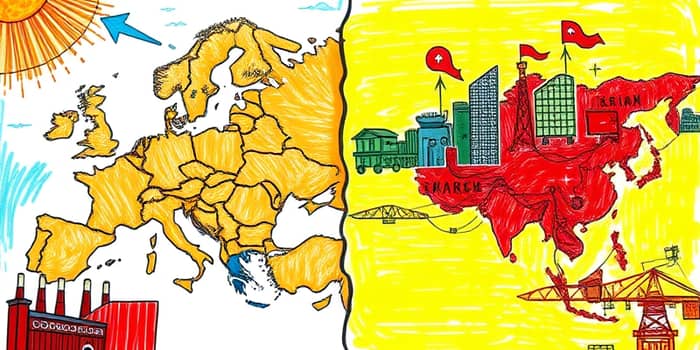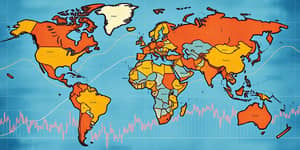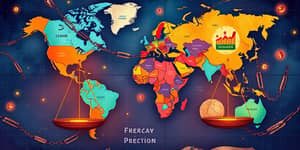From the dawn of the 15th century to the dawn of the 21st, the world has witnessed a dramatic reshaping of economic fortunes. The Great Divergence stands as a testament to human ingenuity, ambition, and the forces that propel some societies ahead while others lag behind.
Understanding the historic widening gap in wealth between Western nations and the rest of the world reveals not only past triumphs but also guides future policy and global cooperation.
Origins and Early Drivers of the Divergence
The seeds of inequality were sown during the Age of Exploration as European powers forged trade routes to Asia, Africa, and the Americas. Merchant fleets and colonial ventures created unprecedented capital flows and gave birth to modern global trade.
By the late 16th century, Western Europe began to outpace other regions in manufacturing and maritime dominance, marking the first phase of widening disparities.
- Industrialization and technology adoption
- Institutional and cultural frameworks
- Geographic and resource advantages
- Globalization and trade networks
These core forces set the stage for centuries of economic growth concentrated in Britain, the Netherlands, and later the United States, while much of Asia and Africa remained largely agrarian and undervalued.
Institutions such as property rights, legal systems, and early banking played an outsized role in enabling Western merchants and inventors to reinvest profits into innovation and infrastructure.
The Industrial Revolution and Western Ascendancy
Between 1760 and 1840, the Industrial Revolution unleashed a wave of mechanization, powered by coal and steam engines. Factories sprouted across Lancashire, Ruhr, and New England, bringing massive productivity gains.
Technological breakthroughs in textiles, metallurgy, and transportation transformed local economies into global powerhouses, fueled by access to navigable rivers and abundant coal.
At the same time, educational reforms and scientific societies disseminated knowledge rapidly, cementing Western Europe’s advantage and enabling it to dominate markets across the globe.
This remarkable ascent created a persistent gulf in living standards, with GDP per capita in Western nations often exceeding that of “the Rest” by factors of five or more.
Shifting Tides: The Great Convergence
Since the 1980s, the winds have begun to shift. Rapid economic liberalization in East Asia, most notably China, India, South Korea, and Vietnam, has sparked a new era of catch-up growth.
- Economic reforms and opening to trade
- Technology transfers and innovation hubs
- Demographic dividends and urbanization
By 2017, Asia accounted for 34% of world GDP, while China alone contributed nearly 15%. This phenomenon, dubbed the Great Convergence, has narrowed the gap created centuries earlier.
As factories hum in Shenzhen and software centers thrive in Bangalore, these economies illustrate that the forces driving early Western growth can be reactivated elsewhere under conducive policies.
Persistent and Emerging Divides
Yet convergence remains uneven. Sub-Saharan Africa and parts of Latin America struggle with low industrialization, political instability, and debt burdens. Per capita incomes in these regions often remain a fraction of global averages.
Within the developing world, continued underinvestment in infrastructure has compounded inequalities. South-South divergences now shape new fault lines, as some nations leap forward while neighbors stagnate.
These emerging divides raise critical questions: How can global markets be structured to facilitate catch-up without repeating past mistakes of exploitation? What policies can bridge gaps in education, healthcare, and digital access?
Looking Forward: Markets, Technology, and Equity
The next phase of global economic evolution will be driven by digital transformation, renewable energy, and innovative finance. Governments and corporations must collaborate to ensure that emerging technologies benefit all societies, not just the wealthiest.
By investing in education, strengthening institutions, and fostering inclusive growth, policy-makers can dismantle barriers that have persisted for centuries. Harnessing digital technology, education, climate change mitigation, and equitable trade frameworks will determine whether the Great Divergence ever fully closes.
In reimagining global markets with fairness at their core, we honor the lessons of history while forging a path toward shared prosperity. With solidarity, vision, and determination, the walls that once separated rich from poor can be replaced by bridges of opportunity.
Ultimately, understanding the Great Divergence and its reversal is not merely an academic exercise—it is a call to action. By learning from the past, we have the power to shape a future in which economic justice and human dignity flourish across all continents.
References
- https://thepangean.com/Understanding-the-Great-Divergence-and-the-Great-Convergence
- https://en.wikipedia.org/wiki/Great_Divergence
- https://academic.oup.com/book/458/chapter/135240022
- https://cepr.org/voxeu/columns/great-divergence-south-south-divergence
- https://branko2f7.substack.com/p/the-origins-of-the-great-divergence
- http://www.inquiriesjournal.com/articles/917/the-great-divergence-redefined-the-rise-and-fall-of-the-west-and-the-recovery-of-china










